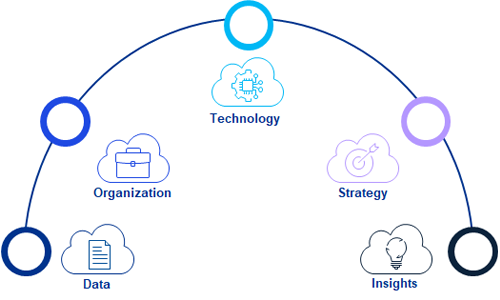Steps to modernize your D&A strategies to manage risk
D&A Modernization | Components and framework

Often the most challenging steps in establishing a data and analytics (D&A) strategy and framework are the first steps. Companies across all industries are facing a push to modernize their D&A platforms, and each has a unique set of needs and goals in this transformation. Understanding where challenges can arise is essential to achieving these goals.
There are a common set of questions or observations for risk leaders at the crossroads of a big strategic decision, such as:
- My analytics processes and technology are failing to provide the benefits we expected.
- How do we stablish enterprise-wide scalable and repeatable processes and controls?
- How can we effectively utilize and improve our data that is disparate and unreconciled?
- How do we clarify our governance processes to reflect our evolving capabilities?
To support organizations struggling with these challenges and questions, we developed the Data, Organization, Technology, Strategy (DOTS) framework. The DOTS framework allows organizations to understand, assess and align their D&A strategy and efforts with their business goals. Determining the right balance in data, organization, and technology enables organizations to make collaborative, mutually beneficial decisions that can drive long-term value.
Data, Organization, Technology, Strategy (DOTS) Framework
The DOTS framework allows organizations to understand, assess and align their D&A strategy and efforts with their business goals.

Technology
A consistent technology stack coordinates data collection, integration and management, enables teams to perform high quality real-time customer analytics, and effectively collaborate and consume those insights through integration with business processes
Storage & Integration | Collaboration & Consumption
Organization
A globally aligned operating model coordinates activity to avoid duplication, share learnings, insights and models, and build digital literacy across the regions.
Structure & Roles | Expertise & Fluency
Strategy
The organization shares a vision for advanced analytics, drives a data-driven culture, and prioritizes the work to remain laser focused on the customer, while also executing consistently and at high quality across all regions.
Vision & Culture | Execution & Alignment
Data
Internal and external data required to understand customer needs and issues are collected, made accessible to the right teams, and are maintained at high quality.
Policies & Access | Management & Quality
Insights
Models and analytics are monitored to ensure value delivery, effective business process implementation, and appropriate governance, risk and controls.
Scalability & Controls | Value & Usability
That first step in any D&A strategy is understanding what data are available and what tools, people and processes need access to that data. This initial step focuses on data, because it provides tremendous insight into priorities of the organization, limitations for near-term strategy goals, and opportunities to improve the information culture. Everything else relies on data management. Additionally, an organization needs to consider how that data will be stored, and how to hire / engage the right people to catalog, maintain, and provide that data to the downstream users who require it.
Next the technology architecture needs to be defined. Once an organization knows the data strategy, it is capable of designing a technology architecture to enable success. It is critical to consider existing internal capabilities, as well as new tools and external support that may be required to get the architecture off the ground.
Once the data and technology requirements have been determined, the organization needs to begin designing and building their team. A new D&A strategy requires specialized skills that should be defined before they can be turned into job descriptions, head count assessments, organizational charts and recruiting efforts. It is also important to consider how existing team members may be re-skilled to take advantage of the new ways of working in a data-driven environment.
After the data, team, and technology are in place is time for the organization to focus on execution at scale. Proofs of concept (POCs) are a great way to start, but the organization should also remain focused on how to achieve enterprise scale for their D&A initiatives. Collaboration is essential at this point. POCs run the risk of becoming established standards. Critical eyes from all parties are needed to determine how benefits are realized for all stakeholders and what else can be done to improve the POC into a production-ready solution.
While D&A modernization may appear overwhelming, with the right guidance and the DOTS framework in place, the journey can lead to lasting enterprise-wide value in the form of cost take-out, increased efficiency, and process optimization.
D&A Strategy – Components of a D&A Modernization Strategy
There are five areas critical to the successful implementation of a modern data and analytics strategy: Data, Technology, Process Optimization, Governance, and Change Management.
Additionally, we have identified certain limitations in the projects delivered over the last few years. Projects that focus on cloud-platform design and implementation may be at-risk by an organization with poor data quality management or analytics. End-users may not be properly trained to adopt the new technology. Analytics engagements may be at-risk in organizations with weak computing power and uncoordinated data flows. By approaching the D&A ecosystem holistically and establishing an enterprise-wide D&A modernization strategy we can better identify these risks for clients and solve them head-on.
While Data and Analytics (D&A) investment and capability has exploded in recent years, often the advancements have outpaced operational and logistical frameworks within organizations yielding optimization opportunities and unrecognized value.
We have an established approach that aligns strategic initiatives with project design and drives successful adoption. Our evidence-based assessment creates consensus for identifying areas of opportunities, and the depth and breadth of our skills generate unique insights and tools for strategic transformations.
Data
An analytics ecosystem is built on clean, accurate, and available data. Without the appropriate data systems, platform, and architecture the value generated by upstream analytics will be limited. A solid data foundation allows for more frequent and accurate analytics results, increased automation, enhanced reporting capabilities, and pain-free deployment.
Technology
Like data, technology unlocks the true value of advanced analytics such as AI and Machine Learning. By effectively managing software, processing, and other analytics capabilities new opportunities to streamline existing processes begin to emerge.
Operations, Processes, and Efficiency Drivers
By integrating technology and data into day-to-day operations efficiencies begin to emerge reducing both the time and level-of-effort required to complete current processes and freeing up more time to focus on strategy and business initiatives.
Governance
With a high degree of investment in D&A solutions, supporting processes to govern and manage the technology stack must be defined and executed upon. Cross-functional governance must review and enforce program objectives and process requirements to ensure the consistent and appropriate execution of the D&A strategy and framework throughout the enterprise.
Change Management
People are the backbone of every organization and primary risk of transformational projects is the failure of the business to adopt the output. The implementation of an enterprise-wide D&A strategy will only be successful if effective training is provided to teach the end-users the skills and knowledge required and a structured approach to measuring the success of the implemented changes both during and after the implementation is in place.
How KPMG can help
KPMG offers extensive experience and leadership across every major industry, including health care, insurance, and financial services, in the areas of model development lifecycle, cloud-based development, operational/organizational design and change management.
Explore more
Meet our team



